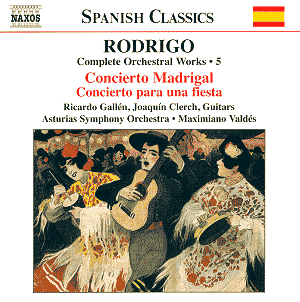As
a one-work composer it is surprising to find that Rodrigo never
thought he had exhausted the possibilities offered by the combination
of guitar and orchestra. Although purely classical in form and
sound the Concierto para una fiesta was written as recently
as 1982. This brief lifespan may in part account for its obscurity.
It was composed (as the name suggests) for a party; in fact it
was commissioned by wealthy Texan parents for performance at a
party for their debutante daughters. This rather nauseating provenance
may have had an impact on Rodrigo too – even the booklet notes
for this recording say "this is not his finest work."
Nonetheless, there is much in this piece that is attractive and
certainly worth hearing. The other drawback that it is always
going to face, being in classical three-movement form and composed
for just one guitar and small orchestra, is comparison with the
work. Indeed, the slow movement has several similarities to that
of the Concierto de Aranjuez, not least the languorous
cor anglais solo at the opening. The balance between orchestra
and guitar is well maintained, the work is made of thin polyphonic
lines and unaccompanied solo passages for the guitar. There is
breadth and a certain spaciousness in the timbres and, while not
of the calibre of the work, this is an interesting late
composition from one of the twentieth centuries more conservative
but still underrated and individual masters.
The
Concierto Madrigal is a different kettle of fish. One of
Rodrigo’s best known works this long suite-like work for two guitars
and orchestra is a masterpiece in every respect. Its ten movements
cover a gamut of emotions and yet the form is tightly unified
by the constant presence of the renaissance madrigal O felici
occhi miei (O happy eyes of mine). As with his Fantasía
para un gentilhombre (based on music by Fernando Sor) Rodrigo
had a knack for finding just the right early music to resonate
with his more romantic treatments. The Concierto Madrigal achieves
this resonance with sparkle and flair and the presence of two
guitars sets up some deliciously plangent textures both within
the pairing and between the guitars and the orchestra. It is all
great fun and very beautiful.
Although
the Concierto para una fiesta is somewhat less than a masterpiece,
it makes a good pairing with the Concierto Madrigal as
the disc would be worth buying for the latter work alone and the
Concierto para una fiesta is at least diverting and unknown
to most listeners. The soloist, Ricardo Gallén, is young
and technically brilliant. There is none of that unpleasant fingerboard
sliding that is apparent on too many guitar recordings. Of course,
it is always difficult to record such a soft instrument in conjunction
with orchestra and this often leads to mics being placed very
close to the guitar. Naxos’ engineers have fortuitously avoided
that particular pitfall here and yet the recording balance keeps
the guitar presence clear, although the overall balance is probably
more like one would expect live than on a recording. This writer
prefers the naturalistic balance as it does eliminate the sounds
of technique that close mic placing reveals. The Concierto
Madrigal has fewer such problems with two guitars producing
enough volume to avoid easy swamping by the orchestra. That having
been said, this is also due to the way in which Maximiano Valdés
handles his forces of the Asturias Symphony Orchestra. This band
is one of the more obscure regional orchestras of Spain but shows
itself as a distinguished group, particularly given some very
fine wind soloists. At the budget price of Naxos discs this sort
of attractive repertoire, in technically assured, musical and
well-recorded performances such as this, can only be recommendable.
It is a very enjoyable and atmospheric disc.
Peter
Wells
see
also review by Rob
Barnett
